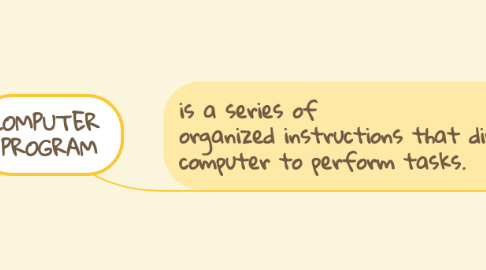
1. is a series of organized instructions that directs a computer to perform tasks.
1.1. DEVELOPMENT TOOLS
1.1.1. It is the software developers use to create, debug, maintain, or otherwise support other programs and applications.
1.1.1.1. EDITOR
1.1.1.1.1. allows the user to enter the program source code and save it to files
1.1.1.2. COMPILER
1.1.1.2.1. A computer program which reads source code and outputs assembly code or executable code
1.1.1.3. PREPROCESSOR
1.1.1.3.1. adds to or modifies the contents of the source file before the compiler begins processing the code
1.1.1.4. LINKER
1.1.1.4.1. compiled code from other sources to make a complete executable program.
1.1.1.5. DEBUGGERS
1.1.1.5.1. allows a programmer to more easily trace a program’s execution in order to locate and correct errors in the program’s implementation.
1.1.1.6. INTEGRATED DEVELOPMENT ENVIRONMENT (IDE)
1.1.1.6.1. includes editors, debuggers, and other programming aids in one comprehensive program.
1.1.1.7. NETBEANS
1.1.1.7.1. It helps you organize your project and integrates with Git for version control.
1.1.1.8. SimpleMDE
1.1.1.8.1. renders your markdown while you write to show you the expected result.
1.1.1.9. GERRIT
1.1.1.9.1. It integrates with Git to let your team review diffs in a side-by-side view, and allows for inline commenting.
1.1.1.10. SLACK
1.1.1.10.1. is a great system for keeping everyone involved with your project on the same page.
1.1.1.11. JIRA
1.1.1.11.1. It allows you to customize your workflow and keep track of every issue your team is working on.
1.2. PROGRAMMING TERMS
1.2.1. Algorithm
1.2.1.1. is rules designed to solve a definite problem.
1.2.2. Boolean
1.2.2.1. is an expression used for creating statements that are either TRUE or FALSE.
1.2.3. Data Types
1.2.3.1. it tells the compiler or interpreter how the programmer intends to use the data.
1.2.4. Constants
1.2.4.1. used to describe a value that does not change throughout the execution of the program, unlike a variable.
1.2.5. Conditionals
1.2.5.1. it perform different actions depending on the need of the programmer, and multiple conditions can be combined into a single condition, as long as the final value of the condition is either TRUE or FALSE.
1.2.6. Declaration
1.2.6.1. helps the compiler or interpreter identify the word and understand its meaning, and how the process should be continued.
1.2.7. Variable
1.2.7.1. stores temporary data within a program which can be modified, store and display whenever need.
1.2.8. Pointer
1.2.8.1. improves the performance of the program as it is cheaper in time and space to copy and dereference pointers than to copy and access the data to which the pointer is referring.
1.2.9. Compilation
1.2.9.1. is a program that translates computer programs written using letters, numbers, and characters into a machine language program.
1.2.10. Framework
1.2.10.1. it allows the developers to bypass the general necessities and focus on more project-related specifics.
1.3. Programming Languages
1.3.1. Python
1.3.1.1. used for data mining and visualisation, machine learning, web applications, and game development.
1.3.1.2. it was developed by Guido van Rossum
1.3.2. Java
1.3.2.1. it was designed to feel similar to C++ but simpler to use. Is also a high-level, object-oriented language.
1.3.2.2. was originally developed by James Gosling at Sun Microsystems
1.3.3. Ruby
1.3.3.1. used for web app development, robotics, networking, system administration and security. It is great for simulations
1.3.3.2. it was developed in the mid-1990s by Yukihiro "Matz" Matsumoto
1.3.4. C
1.3.4.1. used to develop low-level applications
1.3.4.2. it was developed in the early 1970s by American computer scientist Dennis M. Ritchie at Bell Laboratories
1.3.5. C#
1.3.5.1. used for developing Windows desktop applications and games.
1.3.5.2. it was developed in 2000 by Anders Hejlsberg at Microsoft
1.3.6. C++
1.3.6.1. is used a lot to work with System/Application Software, Drivers, Client-Server Applications and Embedded Firmware.
1.3.7. PHP
1.3.7.1. worked with webforms and databases and could be used to build simple, dynamic web applications.
1.3.7.2. it was developed in 1994 by Rasmus Lerdorf
1.3.8. Swift
1.3.8.1. It was created to preserve the main concepts of Objective-C (the other programming language you can use for iOS development), but to also catch bugs in a more eloquent way.
1.3.8.2. it was developed by Apple Inc. and open-source contributors
1.3.9. Go(or Golang)
1.3.9.1. it was designed to help solve “Google-sized” problems, it is great for complex problems.
1.3.9.2. was developed by Google in 2017 to improve programming productivity.
1.3.10. VB.NET
1.3.10.1. used to create a wide range of applications and components
1.3.10.2. developed by Microsoft.
